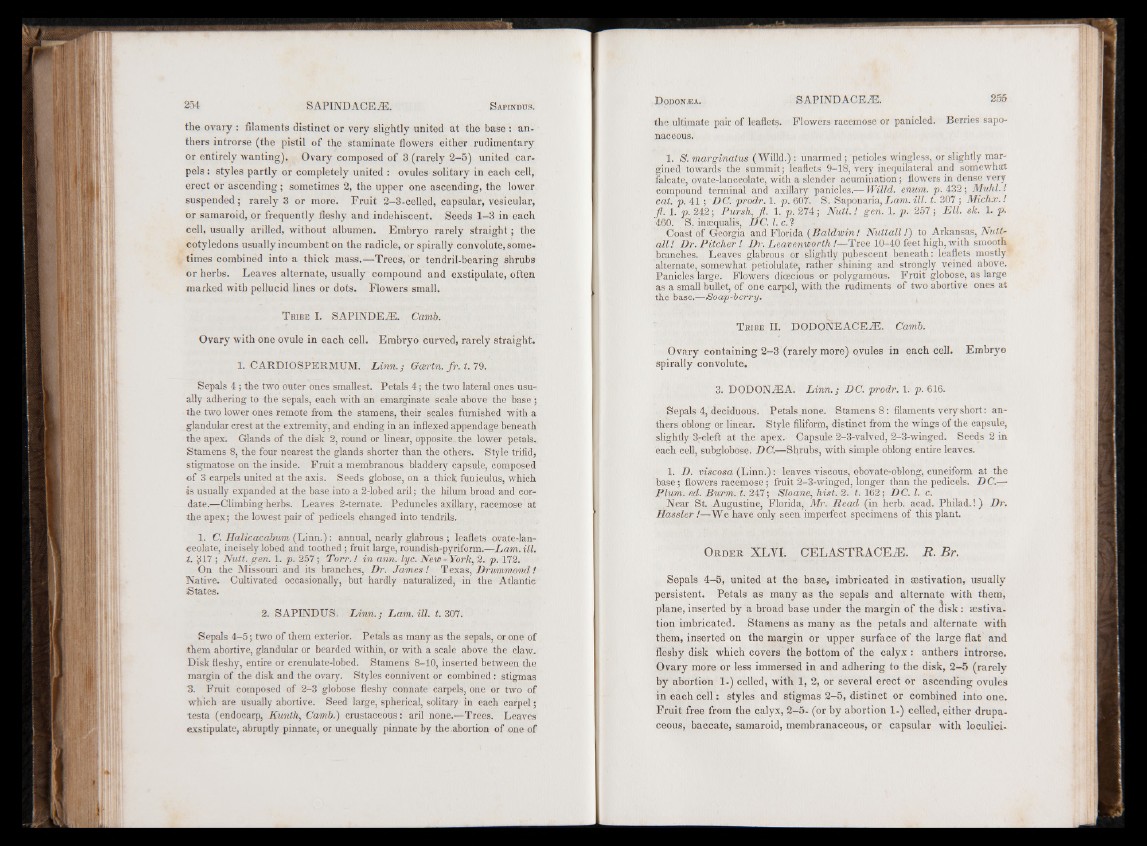
the ovary : filaments distinct or very slightly united at the base : anthers
introrse (the pistil o f the staminate flowers either rudimentary
or entirely wanting). Ovary composed o f 3 (rarely 2 -5 ) united carpels
: styles partly or completely united : ovules solitary in each cell,
erect or ascending; sometimes 2, the upper one ascending, the lower
suspended ; rarely 3 or more. Fruit 2-3-celled, capsular, vesicular,
or samaroid, or frequently fleshy and indéhiscent. Seeds 1 -3 in each
cell, usually arilled, without albumen. Embryo rarely straight ; the
cotyledons usually incumbent on the radicle, or spirally convolute, sometimes
combined into a thick mass.—Trees, or tendril-bearing shrubs
or herbs. Leaves alternate, usually compound and exstipulate, often
marked with pellucid lines or dots. Flowers small.
T ribe L SAPINDEÆ. Camb.
Ovary with one ovule in each cell. Embryo curved, rarely straight.
Î. CARDIOSPERMUM. L in n .; Gqirtn.fr. t. 79.
Sepals 4 ; the two outer ones smallest. Petals 4 ; the two lateral ones usually
adhering to the sepals, each with an emarginate scale above the base ;
the two lower ones remote from the stamens, their scales. furnished with a
glandular crest at the extremity, and eliding in an inflexed appendage beneath
the apex. Glands of the disk 2, round or linear, opposite, the lower petals..
Stamens 8, the four nearest the glands shorter than the others. Style trifid,
stigmatose on the inside. Fruit a membranous bladdery capsule, composed
o f 3 carpels united at the axis. Seeds globose, on a thick funiculus, which
is usually expanded at the base into a 2-lobed aril ; the hilum broad and cordate.—
Climbingherbs. Leaves 2-ternate. Peduncles axillary, racemose at
the apex; the lowest pair of pedicels changed into tendrils.
1. C. Halicacabum (Linn.) : annual, nearly glabrous ; leaflets ovate-lanceolate,
incisely lobed and toothed ; fruit large, roundish-pyriform.—Lam. ill.
t. ÿl7 ; Nutt. gen. 1. p. 257 ; Torr.l in ann. lyc. New - York, 2. p. 172.
On the Missouri and its branches, Dr. James ! Texas, Drummond f
Native. Cultivated occasionally, but hardly naturalized, in the Atlantic
States.
2. SAPINDUS. Lin n .; Lam. ill. t. 307.
Sepals 4-5; two of them exterior. Petals as many as the sepals, or one of
them abortive, glandular or bearded within, or with a scale above the claw.
Disk fleshy, entire or crenulate-lobed. Stamens 8- 10, inserted between the
margin of the disk and the ovary. Styles connivent or combined : stigmas
S. Fruit composed of 2-3 globose fleshy connate carpels, one or two of
which are usually abortive. Seed large, spherical, solitary in each carpel ;
testa (endocarp, Kunth, Camb.) crastaceous: aril none.—Trees. Leaves
exstipulate, abruptly pinnate, or unequally pinnate by the abortion of one of
the ultimate pair of leaflets. Flowers racemose or panicled. Berries saponaceous.
1. S. marginatus (Willd.) : unarmed; petioles wingless, or slightly margined
towards the summit; leaflets 9-18, very inequilateral and somewhat
falcate, ovate-lanceolate, with a slender acumination; flowers in dense very
compound terminal and axillary panicles.— Willd. enum. p. 432; Muhl.l
cat. p. 41 ; DC. prodr. 1. p. 607. S. Saponaria, Lam. ill. t. 307 ; Michx.!
fl. 1. p. 242; Pursh, fl. 1. p. 274; N u tt.! gen. 1. p. 257; Ell. sk. 1. p.
460. S. insequali^, D C.l.c.1 -
Coast of Georgia and Florida [Baldwin! Nuttall ƒ) to Arkansas, Null-
all! Dr. Pitcher ! Dr. Leavenworth !—Tree 10-40 feet high, with smooth
branches. Leaves glabrous or slightly pubescent beneath: leaflets mostly
alternate, somewhat petiolulate, rather shining and strongly veined above.
Panicles large. Flowers dioecious or polygamous. Fruit globose, as large
as a small bullet, of one carpel, with the rudiments of two abortive ones at
the base.—Soap-berry.
T ribe H. DODONEACEzE. Camb.
Ovary containing 2 -3 (rarely more) ovules in each cell. Embryo
spirally convolute.
3. DODONiEA. Lin n .; DC. prodr. 1. p. 616.
Sepals 4, deciduous. Petals none. Stamens 8 : filaments very short: anthers
oblong or linear. Style filiform, distinct from the wings of the capsule,
slightly 3-cleft at the apex. Capsule 2-3-valyed, 2-3-winged. Seeds 2 in
each cell, subglobose. DC.—Shrubs, with simple oblong entire leaves.
1. D. viscosa (Linn.): leaves viscous, obovate-oblong, cuneiform at the
base; flowers racemose; fruit 2-3-winged, longer than the pedicels. DC.—
Plum. ed. Burm. t. 247; Sloane, hist. 2. t. 162; DC. 1. c.
Near St. Augustine, Florida, Mr. Read (in herb. acad. Philad.! ) Dr.
Hassler !—We have only seen imperfect specimens of this plant.
Or d e r X LY I. C E L A S T R A C E iE . R . B r .
Sepals 4 -5 , united at the base, imbricated in aestivation, usually
persistent. Petals as many as the sepals and alternate with them,
plane, inserted by a broad base under the margin o f the disk : aestivation
imbricated. Stamens as many as the petals and alternate with
them, inserted on the margin or upper surface o f the large flat and
fleshy disk which covers the bottom o f the calyx : anthers introrse.
Ovary more or less immersed in and adhering to the disk, 2 -5 (rarely
by abortion 1-) celled, with 1, 2 , or several erect or ascending ovules
in each c e ll: styles and stigmas 2 -5 , distinct or combined into one.
Fruit free from the calyx, 2 -5 - (or by abortion 1-) celled, either drupaceous,
baccate, samaroid, membranaceous, or capsular with loculici